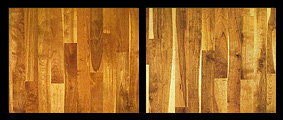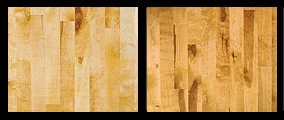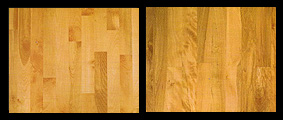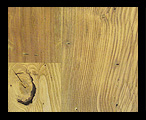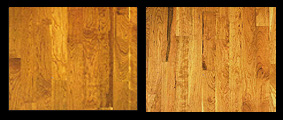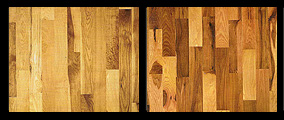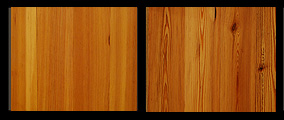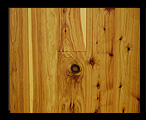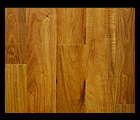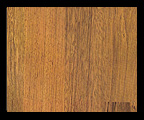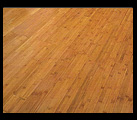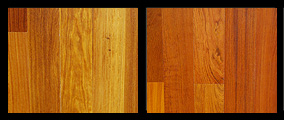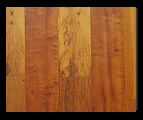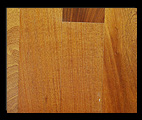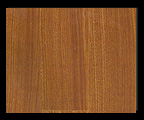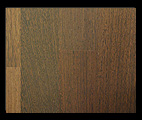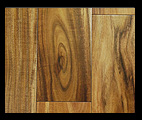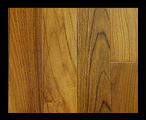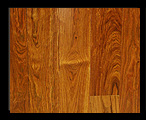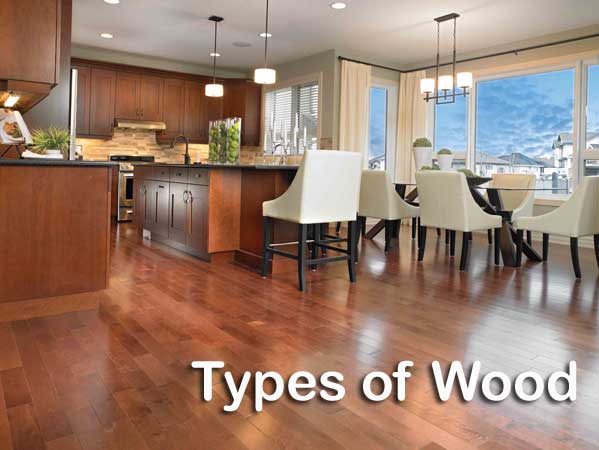
Species of Wood Flooring
As part of our philosophy, All American Hardwood Flooring educates their customers on all aspects of a hardwood floor including species, grade and hardness. Based on the traffic in your home or office and the desired look you want to achieve, we will recommend species of wood that fit your particular situation.
Natural Characteristics are ones that have been shaped by natural forces. They often display the following in the different grades of wood:
Burls -
Rounded growths on a tree which produce curling, ornamental patterns in
lumber.
Knots - Hard,
cylindrical regions marking locations of branches that have been encased
by later growth of the tree.
Mineral Streaks
- Olive or grayish markings caused by such environmental factors as
trace elements in water or soil.
Grain - The
direction, size, appearance and quality of the fibers that give
hardwoods strength and distinctive patterns.
Growth Rings
- Layers of wood added to a tree during a single growing season.
Click on the samples below to learn about that particular species.
Domestic Woods
White Oak
White Oak was a large contributor to early America and was vital during the Industrial Revolution. It was used for wagon wheels, tools and ships. White Oak is more dense and heavier than Red Oak which makes it slightly more durable of the two. Rooms that are subject to high traffic usually use White Oak. Different looks can be achieved by choosing between grades and cuts (plainsawn, quartersawn, and riftsawn).
| Clear | Most uniform in color consisting of mostly heartwood |
| Select | Similar to clear, but may contain natural characteristics |
| #1 Common | Will offer a variety of color, mineral streaking, and smaller knots |
| #2 Common | Numerous color variations and larger natural aspects |
Red Oak
These woods grow predominately in the Eastern half of the United States with Red Oak being the most abundant. It was used as railroad crossties, fence posts, and mining timbers. Usually reddish in tone in its natural state; however, the species takes stains of varying colors quite well. Northern Red Oak is more uniform in color, with a desirable, rich wheat hue and tighter more closely held grain pattern which mellows the floors overall appearance.
| Clear | Most uniform in color consisting of mostly heartwood |
| Select | Similar to clear, but may contain natural characteristics |
| #1 Common | Will offer a variety of color, mineral streaking, and smaller knots |
| #2 Common | Numerous color variations and larger natural aspects |
Red Birch
Selected from the heartwood of Yellow Birch. This is the rarest of the domestic exotics and arguably the most sought after flooring in North America. Its reddish-brown distinguishing glow combined with its closed grain and flare offers and amazing and spectacular floor. Same durability and hardness as Oak. Rarest flooring material in North America.
| Select and Better | Contains a minimum of 95% brownish-red blush that makes this floor so amazing. May be occasional small pin knots and occasional dark streaks. |
| Common | Contains 50% or more of the deep brownish-red blush. Varying wood characteristics, numerous streaks, discolored sapwood, sound knots and some checks. |
Yellow Birch
North American domestic exotic. Particular to the northern great lakes region. Has straight, closed grain and color variance from creamy yellow to very light reddish brown. Its beauty tends to intensify with age as the wood mellows and ambers. Same hardness as Red Oak.
| Select and Better | Contains more than 50% of sapwood, occasional small tight pin knots and occasional dark streaks. |
| Common | Sapwood and it has varying wood characertistic, numerous streaks, discolored sapwood, sound knots and some checks. Dynamic in color. |
Walnut
This wood has a very distinctive color with extreme contrast between the nearly white sapwood from the outside of the tree to the dark chocolate brown with a slight purple tinge of the heartwood. Higher grades typically have a larger percentage of heartwood and less of the white sapwood. The grain is predominately straight with occasional burly patterns if the wood has been cut close to a limb. This achieved look is perfect for those looking for flooring from a formal rooms to country homes and lodges depending on the cut. Walnut is 20% softer than Red Oak.
| Select and Better | Uniform and consistent, dark and rich. Occasional small knots and minimal sapwood. |
| Common | May contain prominent color variation between the very light sapwood and the dark heartwood. It has numerous small knots. |
| Character | Burly pattern, large knots, very dramatic, a lot of white sapwood. |
Ash
A fantastic character wood. Ash displays perhaps the most wonderfully pronounced grain of any hardwood. It has a wide to broad range of grains and color that make it uniquely the most consistent choice for those looking for character wood or a real wood feel. Ash stains extremely well and its grain characterstics allow it to highlight a beauty only nature can provide. Ash is more durable, harder than Oak.
| Select and better | Contains mostly sapwood, occasional narrow streaks and small pin knots. |
| 1 Common | Contains a wide variety of wood characteristics. Heavy streaks, discolored sapwood and some small knots. |
| 2 Common | Wide, wild varying wood characteristics such as heavy streaks, discolored sapwood and numerous small knots. |
Beech
Considered a North American domestic exotic the beauty of Beech is in its simple grain and uniformity by grade. Color ranges from pale white to reddish brown. The color tones, however, are mellowed and bleed through the steaming process. Very contemporary flooring.
| Select and Better | Wonderfully uniform with slight varying color characteristics, all natural with few and occasional small pin knots and rare dark streaks. |
| Common | Varying color characteristics, numerous streaks and discolored sapwood, sound knots and some checks. |
Chestnut
Once the dominant forest species east of the Mississippi River, the American Chestnut has disappeared as a large tree since the accidental introduction of the Chestnut blight from Asia around the turn of the 20th century. It can still be found coming up from old roots, and occasionally produces fruit before succumbing to the blight. Most wood from this species can come from reclaimed farm buildings and log homes up to 200 years old, however will more frequently come from buildings built this century from trees killed by the blight. It will have worm holes caused by the beetle infestation.
Back to TopAmerican Cherry
Considered the premier of North American hardwoods. Varying grades allow a floor that is grand or casual in the floors appearance. Extremely light sensitive, cherry darkens dramatically over time and character marks become distinguishing features. Color can range significantly between boards, with shades ranging from light to dark reddish-brown to light pink. Cherry is 25% softer than Red Oak.
| Select and Better | Little natural color variation found in the heartwood and very small amount of contrasting sapwood. Occasional small pin knots and tiny black streaks. |
| Common | Prominent color variation between the light sapwood and the dark heartwood and may also have numerous knots and black streaks. |
Hickory/Pecan
This wood is commonly known to be hard as stone, heavy as lead and strong as an ox. These unique characteristics make Hickory/Pecan woods durable for any application. Variations in the grade can result in quite significantly different looking floors. They can go from white to a reddish brown and the amount of natural character marks like knots and sap pockets can make the flooring look extremely rustic or quite refined. This wood is usually mixed with pecan as both woods are very similar. It should be noted that using wider planks tend to present the floor as having less action.
| Select | Some color variation, an occasional pin knots and minimal dark streaks, sound knots, bird peck from board to board. |
| Rustic | Contains wild color variations and dramatic wood characteristics. Colors range from dark to nearly white, includes discolored sapwood, heavy dramatic streaks, sound knots, checks and splits. |
Maple Hard and Red
This hardwood is found through most of North America. The most common flooring option after Red and White Oak. Commercial species are concentrated in the eastern United States and Canada, particularly in the mid-Atlantic and Lake states. This is the best choice if you are looking for a light, uniform appearance. Super durable, it is considered one of the hardest of all hardwoods. This makes for a super stable floor. With premium grading this floor is exclusively specified by architects and super high-end designers looking for the ultimate contemporary product. The sapwood of sugar maple is a lovely creamy white, while the heartwood ranges from creamy white to light reddish brown. This wood has a closed, subdued grain and a uniform texture, with medium figuring Natural grading of this floor is perfect for a not so intimidating light colored floor. Rustic graded maple is a fantastic cabin grade or rustic floor. Its durability combined with its casual and homey feel make it a perfect floor of character fantastic cabin grade floor. Another grading of maple is variously described as quilted, curly, "bird's-eye," and "fiddleback." This is Natures most desired imperfection. During the grading process, interestingly figured boards are often culled from the group and sold at a premium.
Red Maple is a beautiful and unique floor that is distinguished by its scarcity.
| Premium | Almost white and nearly uniform in color an grain. It is predominately sapwood with a few slight color variations. The major aspect of this floor is that the grain all runs tangent to the face of the flooring and runs parallel with the length. |
| Natural | Varying wood characteristics and colors to include distinct color variations and may be discolored sapwood, occasional sound knots and dark streaks. |
| Rustic | Wide ranging characteristics and colors of distinct variations from bright white to brown to black streaks. Has numerous small knots, dark streaks and discolored sapwood. |
| Red Maple | Contains a minimum of 95% of the brownish-red hue. Grade may contain the occasional small pin knot. |
|
Birds Eye (Not Pictured) |
Has varying eyes and has varying wood characteristics and colors to include distinct color variations, occasional sound knots and dark streaks. |
Southern Yellow Pine/Northern White Pine
Pine flooring comes from the Yellow and White Pine trees. The Yellow Pine is known as the hard pine. Yellow pine also has more character than White Pine. Both pines are slow growing which is what gives pine its strength and durability. The White Pine was abundant is the northeast when the first colonists arrived. The Kings surveyors soon discovered the trees and the largest of the trees were claimed for the crown. Everything from public buildings to private homes and great plantations used the unique beauty and strength of pine.
There are two categories in both Southern Yellow and Northern White Pine Old Heart Pine and New Heart Pine. Both come in select grades.
Old Heart Pine
Comes from trees that were harvested many years ago. These trees were 200 to 500 years old. Now most heart pine comes from reclaimed lumber sources old barns, mills, public buildings, old subway structures and even found sunk in riverbeds. Old dock pilings and bulkheads make beautiful heart pine floors with unique color and tone .Heart Pine comes from the center section of the Pine tree. Slow growth of the tree produced a tight-grain and is the most dense. Heart pine is graded according to heart content and knot size. Heart can be seen by the amount of red in the material. More red more heart content. All grades will have nail holes except river-recovered.
River-recovered wood is Superior to all heart pine woods due to it being perfectly preserved in pristine condition.
|
Select (75-85% vertical grain depending on width) |
98-100% heartwood, Knots are not over 1 color is rich red, nail holes are average 15 per 100sq ft. |
| Vertical | 98-100% heartwood, knots are not over 1 , color is rich red, nail holes are average 15 per 100 sq ft. |
|
Character (vertical and arching grain) |
75-90% heartwood, knots are up to 2 , rich red in color, nail holes with some staining, yellow sap slight cracks and checks |
|
River Recovered (Virgin wood-never used) |
100% heartwood- Found on bottom of riverbeds, tightly grained, stable and glows with a rich patina after a few months of oxygen and sunlight, fewer and smaller knots, very strong |
New Heart Pine
These trees are younger in age and is typically where new pine flooring is acquired today. The same characteristics apply to New heart pine as stated above.
Grading is done by the amount of heart content.
| Colonial | 85-100% heartwood sound or firm and tight small knots |
| Victorian | 75-100% heartwood with tight decayed knots |
| Country | 50-100% heartwood with south, firm encased pith, decayed knots |
| Tavern | 50-100% heartwood unlimited color variation, no limitation on frequency and size of knots |
Exotic Woods
Australian Cypress
Back to Top
Brazilian Walnut (IPE)
This exotic wood is located in Brazil and throughout continental tropical America as well as in parts of the Lesser Antilles. The heartwood of ipe ranges from olive brown to blackish, though it can have lighter or darker striping that is sharply demarcated from the whitish or yellowish sapwood. Ipe is a low-luster wood with an oily appearance, a fine-to-medium texture, and a grain that ranges from straight to very irregular. This wood is the hardest of all on the JANKA scale.
Back to TopBrazilian Cherry (Jatoba)
Brazilian cherry is a large canopy tree, sometimes reaching a height of 150 feet in the natural rainforest, with a cylindrical trunk up to 6 feet in diameter and a clear bole of 60 to 80 feet. The tree has a smooth gray bark that exudes a gum sometimes used for medicinal purposes.
Brazilian cherry is a very beautiful reddish brown wood, with an interlocking grain and a golden luster or glow beneath. It is a hard, heavy and very strong wood.
Bamboo
Is found predominately throughout Asia Natural bamboo is pale yellow in color, while the carbonized variety of bamboo is more brownish-yellow in color. As a service to our customers, we can obtain a wide variety of other colored bamboo flooring as well. The species has a very linear grain and is fairly smooth in texture.
Back to TopCumaru Light/Dark
Found in Central and South America The sapwood of cumaru is very similar to the heartwood, which ranges from tannish to deep brown in color. Over time the color of Brazilian Teak (as it is sometimes referred to) will "flatten out" slightly. The species has an irregular, slightly interlocked grain and is coarse and wavy in texture.
Back to TopTigerwood
Is located in Latin America, mainly Brazil, Paraguay, and Uruguay. The sapwood of tigerwood is brownish-white to dirty gray, while the heartwood is reddish-brown to light golden-brown in color. The species has a mottled, wavy or interlocked, irregular grain. Tigerwood has a medium to dull luster and is fine in texture.
Back to TopSapele
Is found in West and East Africa, from the Ivory Coast to the Cameroons and eastward through Zaire to Uganda. The sapwood of sapele tends to whitish or pale yellow and is distinct from the heartwood, which ranges in color from a medium to dark reddish or purplish brown. Sapele is lustrous and fine-textured, with an interlocked grain that is sometimes wavy, producing a narrow, uniform roe figure on quartered surfaces. When cut, it has a cedar-like scent.
Back to TopSantos Mahogany
Has a wide distribution, from southern Mexico southward through Central America down to Argentina. The very fine and even texture of this well-known and popular hardwood, along with its striped figuring, complements the attractive dark reddish brown color of mahogany wood flooring. The white sapwood is sharply demarcated from the heartwood. The grain of mahogany is typically interlocked, and the surface can have a medium to high luster. When freshly cut, it has a pleasant spicy scent.
Back to TopWenge
Wenge is found in Central Africa, especially throughout the Congo and southern regions of Tanzania and Mozambique. When freshly cut, the heartwood of wenge (millettia laurentii) is a yellow-brown color, but then in a few months it darkens to a deep, uniform brown, almost black, with alternate layers of light and dark tissue, forming a decorative figure. So it is important to buy well-aged wood before laying the floor. Clearly demarcated from the heartwood is the yellowish-white sapwood. This coarse-textured wood has a straight grain. A related species from East Africa, panga-panga (millettia stuhlmannii) has similar graining but does not darken as much as wenge. One of the best known of the exotic dark woods, wenge is used primarily where a bold dark color or contrasting light and dark accent strips are desired.
Back to TopAcacia
Acacia includes more than one hundred species of trees and shrubs which are found primarily in the arid and semi-arid regions of the world. The slanted flat tops of Acacia trees make them conspicuous in the desert. Because of the slow growth of the tree, the wood is extremely hard and dense. Janka Test rating of 2400). The heartwood is dark red-brown and attractive when polished and is resistant to decay. This is because the tree deposits in the heartwood many waste substances which are preservatives and rend the wood unpalatable to insects making the wood dense and difficult to be penetrated by water and other decay agents.
Back to TopTeak
The sapwood of teak is white to pale yellow, while the heartwood is dark golden-brown to dark golden-yellow to rich brown in color with darker chocolate-colored brown streaks. The species has a straight, occasionally wavy grain and is fairly coarse and uneven in texture. The wood itself can be greasy with shiny white pockets. This species has a
dull luster.
Properties:
Teak has a high resistance to decay and termite attack. In fact the oil secreted by the wood is reported to be a natural insect repellant. The wood remains smooth under friction and is reported to have the odor of leather when freshly cut. Chestnut is
difficult and time consuming to dry properly.
As a flooring option, teak is a somewhat hard and durable wood. It falls between black cherry and black walnut in hardness, is about forty percent harder than Douglas fir, is thirty-one percent softer than sugar maple, is roughly sixty-nine percent as hard as hard maple, and is just over forty-five percent as hard as santos mahogany's ranking of 2200.
Rosewood
Bolivian rosewood is distinctive for its dark brown to violet color with black streaks or striping. Over time, the wood may lighten considerably from darker brown tones to lighter golden tan colors. In addition, the broad color variation exhibited in freshly cut wood can undergo substantial muting over time. It has a uniform and moderately coarse texture.
Properties:
Brazilian rosewood is notably hard and dense, with a dimensional stability similar to that of red oak.
Brazilian rosewood is nearly ninety-seven percent as hard as pecan or hickory, is roughly twenty-two percent harder than hard maple, about eight percent harder than wenge, almost exactly thirty-eight percent harder than red oak, and is roughly eighty percent as hard as santos mahogany's ranking of 2200.
Workability:
Despite its density, Bolivian rosewood works well and sands to a fine natural polish. Many oil-based finishes will not dry properly with this wood, so water-based stains are preferred.


